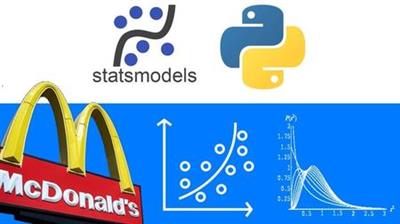Udemy - Machine Learning and Data Science Using Python (2021)
"softddl.org"
5-11-2021, 14:55
-
Share on social networks:
-
Download for free: Udemy -
-

MP4 | Video: h264, 1280x720 | Audio: AAC, 44.1 KHz, 2 Ch
Genre: eLearning | Language: English + srt | Duration: 32 lectures (1h 56m) | Size: 684 MB
Begin your ML and DS Journey

MP4 | Video: h264, 1280x720 | Audio: AAC, 44.1 KHz, 2 Ch
Genre: eLearning | Language: English + srt | Duration: 32 lectures (1h 56m) | Size: 684 MB
Begin your ML and DS Journey
What you'll learn:
Introduction to Python
Data Structures in Python
Control Structures and Functions
Python for Data Science
Introduction to NumPy
Operations on NumPy Arrays
Introduction to Pandas
Getting and Cleaning Data
Data Visualisation in Python
Introduction to Data Visualisation
Basics of Visualisation
Descriptionting Data Distributions
Descriptionting Categorical and Time-Series Data
Requirements
No programming experience is needed.
Description
Module-1
Welcome to the Pre-Program Preparatory Content
Session-1:
1) Introduction
2) Preparatory Content Learning Experience
MODULE-2
INTRODUCTION TO PYTHON
Session-1:
Understanding Digital Disruption Course structure
1) Introduction
2) Understanding Primary Actions
3) Understanding es & Important Pointers
Session-2:
Introduction to python
1) Getting Started - Installation
2) Introduction to Jupyter Notebook
The Basics Data Structures in Python
3) Lists
4) Tuples
5) Dictionaries
6) Sets
Session-3:
Control Structures and Functions
1) Introduction
2) If-Elif-Else
3) Loops
4) Comprehensions
5) Functions
6) Map, Filter, and Reduce
7) Summary
Session-4:
Practice Questions
1) Practice Questions I
2) Practice Questions II
Module-3
Python for Data Science
Session-1:
Introduction to NumPy
1) Introduction
2) NumPy Basics
3) Creating NumPy Arrays
4) Structure and Content of Arrays
5) Subset, Slice, Index and Iterate through Arrays
6) Multidimensional Arrays
7) Computation Times in NumPy and Standard Python Lists
8) Summary
Session-2:
Operations on NumPy Arrays
1) Introduction
2) Basic Operations
3) Operations on Arrays
4) Basic Linear Algebra Operations
5) Summary
Session-3:
Introduction to Pandas
1) Introduction
2) Pandas Basics
3) Indexing and Selecting Data
4) Merge and Append
5) Grouping and Summarizing Data frames
6) Lambda function & Pivot tables
7) Summary
Session-4:
Getting and Cleaning Data
1) Introduction
2) Reading Delimited and Relational Databases
3) Reading Data from Websites
4) Getting Data from APIs
5) Reading Data from PDF Files
6) Cleaning Datasets
7) Summary
Session-5:
Practice Questions
1) NumPy Practice Questions
2) Pandas Practice Questions
3) Pandas Practice Questions Solution
Module-4
Session-1:
Vectors and Vector Spaces
1) Introduction to Linear Algebra
2) Vectors: The Basics
3) Vector Operations - The Dot Product
4) Dot Product - Example Application
5) Vector Spaces
6) Summary
Session-2:
Linear Transformations and Matrices
1) Matrices: The Basics
2) Matrix Operations - I
3) Matrix Operations - II
4) Linear Transformations
5) Determinants
6) System of Linear Equations
7) Inverse, Rank, Column and Null Space
8) Least Squares Approximation
9) Summary
Session-3:
Eigenvalues and Eigenvectors
1) Eigenvectors: What Are They?
2) Calculating Eigenvalues and Eigenvectors
3) Eigen decomposition of a Matrix
4) Summary
Session-4:
Multivariable Calculus
Module-5
Session-1:
Introduction to Data Visualisation
1) Introduction: Data Visualisation
2) Visualisations - Some Examples
3) Visualisations - The World of Imagery
4) Understanding Basic Chart Types I
5) Understanding Basic Chart Types II
6) Summary: Data Visualisation
Session-2:
Basics of Visualisation Introduction
1) Data Visualisation Toolkit
2) Components of a Description
3) Sub-Descriptions
4) Functionalities of Descriptions
5) Summary
Session-3:
Descriptionting Data Distributions Introduction
1) Univariate Distributions
2) Univariate Distributions - Rug Descriptions
3) Bivariate Distributions
4) Bivariate Distributions - Descriptionting Pairwise Relationships
5) Summary
Session-4:
Descriptionting Categorical and Time-Series Data
1) Introduction
2) Descriptionting Distributions Across Categories
3) Descriptionting Aggregate Values Across Categories
4) Time Series Data
5) Summary
Session-5:
1) Practice Questions I
2) Practice Questions II
Who this course is for
Beginner Python developers curious about Machine Learning
Homepage
https://www.udemy.com/course/dd-innovations-ml-ds-python-allBuy Premium From My Links To Get Resumable Support,Max Speed & Support Me
Links are Interchangeable - No Password - Single Extraction
The minimum comment length is 50 characters. comments are moderated






